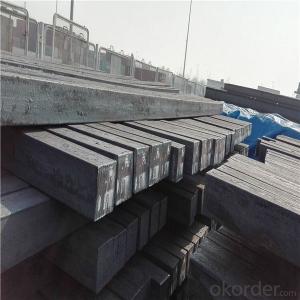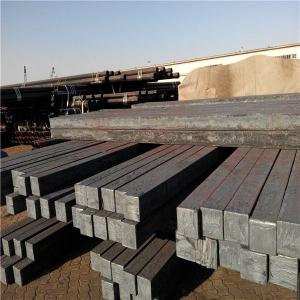Q275 Prime Steel Billet for hot roll steel prosucts
- Loading Port:
- Guangzhou
- Payment Terms:
- TT OR LC
- Min Order Qty:
- 1000 m.t.
- Supply Capability:
- 19983 m.t./month
OKorder Service Pledge
OKorder Financial Service
You Might Also Like
Item specifice
Billets, or ingots (as they sometimes referred to), are not of practical use until they have been formed into
more functional shapes and sizes. While they have already been put in the furnace, they still require a series
of shaping and molding procedures such as hot and cold working, milling and cutting before they are sold in
hardware stores, or used for different applications. The unformed billets, however, can be used in striking
currency such as coins and as reserves, similar to gold bars.
Qaulity:own factory, stable quality
Tolerance: Strictly according to the G/B and JIS standard
Delivery time: within 45 days after receiving the L/C or advanced T/T payment.
Price term: FOB/CIF/ CFR according to clients requirements
.
Gade:
Standard | C(%) | Mn(%) | S(%) | P(%) | Si(%) |
Q195 | ≤0.12 | ≤0.50 | ≤0.040 | ≤0.035 | ≤0.30 |
Q235 | ≤0.20 | ≤1.40 | ≤0.045 | ≤0.045 | ≤0.35 |
Q275 | ≤0.22 | ≤1.50 | ≤0.045 | ≤0.045 | ≤0.35 |
20MnSi | 0.17-0.25 | 1.2-1.6 | ≤ 0.050 | ≤ 0.050 | 0.40-0.80 |
3SP | 0.14-0.22 | 0.40-0.85 | ≤ 0.050 | ≤ 0.040 | 0.05-0.15 |
5SP | 0.28-0.37 | 0.50-1.00 | ≤ 0.050 | ≤ 0.040 | 0.15-0.30 |
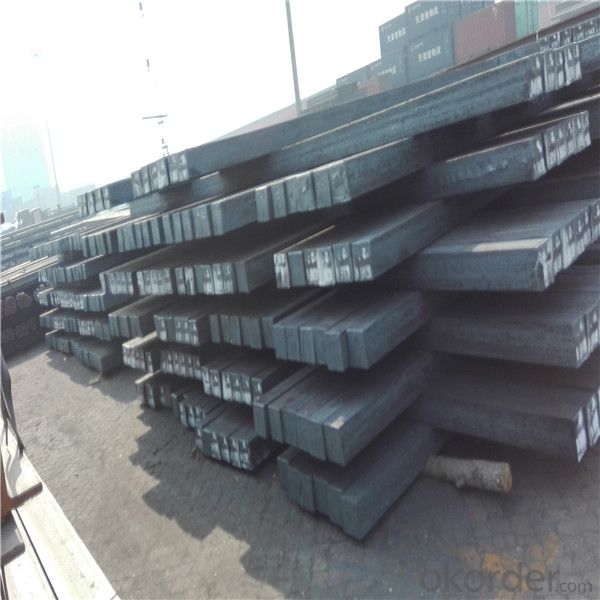
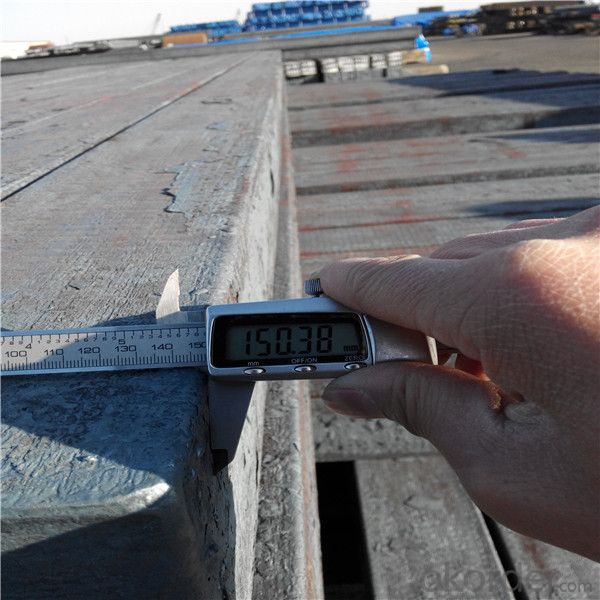
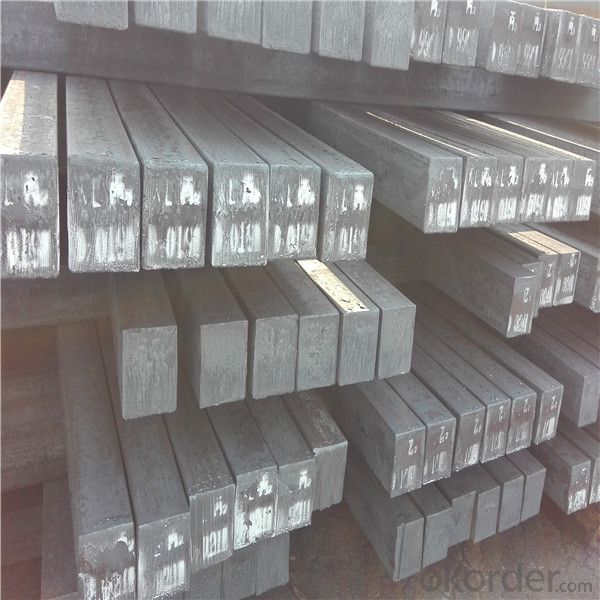
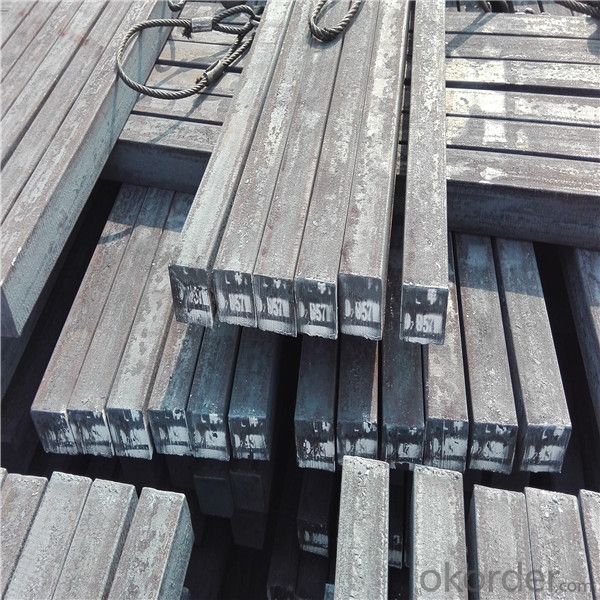
Our service :
We have a plant and professional team to provide our best service, from the start of production until the
loading into the vessel, we have a complete quality follow up procedure, to assure our products arrives to the customer with satisfaction. Welcome new and old customers
to contact us for future business relationships! We will give you a surpise price.
Packing :
Within 30 days
1.Standard export package
2.In bundles with steel strips
3.As the requirements of the customers
FAQ:
Q: What is payment terms?
A: FOB 30% T/T IN ADVANCE AS DEPOSIT AND 70% T/T BEFORE SHIPMENT
CIF and CFR 30% T/T IN ADVANCE AS DEPOSIT AND 70% T/T AS THE COPY OF B/L OR L/C AT SIGHT
Q:How to guarantee the quality of the products?
A:We have established the international advanced quality management system,every link from raw material
to final product we have strict quality test;We resolutely put an end to unqualified products flowing into the market.
At the same time, we will provide necessary follow-up service assurance.
Q:How long can we receive the product after purchase?
A :In the purchase of product within three working days, We will arrange the factory delivery as soon as possible.
The pecific time of receiving is related to the state and position of customers.
- Q:How are steel billets used in the manufacturing of pipes and tubes?
- Steel billets are an essential component in the manufacturing of pipes and tubes. These billets, which are typically rectangular or square in shape, serve as the starting point for the production process. They are first heated to a high temperature to make them more malleable and easier to shape. Once heated, the billets are then passed through a series of rollers, where they are gradually formed into a cylindrical shape. This process, known as hot rolling, helps to refine the structure and improve the mechanical properties of the steel. Hot rolling also ensures that the dimensions of the billet are consistent throughout its length. After the initial hot rolling, the billets are further processed through a series of cold rolling and sizing operations. Cold rolling helps to reduce the thickness and improve the surface finish of the billet, while sizing operations ensure that the final product meets the required specifications in terms of diameter, wall thickness, and length. Once the billet has been shaped and sized, it is then cut into specific lengths and welded together to form a seamless or welded pipe or tube. The welding process involves joining the ends of the billets using either electric resistance welding (ERW), submerged arc welding (SAW), or other welding techniques. This helps to create a continuous and strong joint, ensuring the integrity and strength of the pipe or tube. The final step in the manufacturing process involves various finishing operations such as heat treatment, straightening, and inspection. Heat treatment helps to further enhance the mechanical properties of the pipe or tube, while straightening ensures that the final product has a uniform shape and is free from any deformations. Inspection is carried out to ensure that the pipes or tubes meet the required quality standards and specifications. In summary, steel billets play a crucial role in the manufacturing of pipes and tubes. They are transformed through a series of hot and cold rolling processes, welded together, and subjected to various finishing operations to produce high-quality and reliable pipes and tubes.
- Q:Can steel billets be welded together?
- Yes, steel billets can be welded together. Welding is a common method used to join steel billets by heating the surfaces to a molten state and then allowing them to cool and solidify, resulting in a strong and continuous joint.
- Q:How are steel billets used in the production of aerospace parts?
- Steel billets are used in the production of aerospace parts as they serve as the starting material for forging or machining processes. These billets are heated, shaped, and then further processed to create the desired components, such as engine parts, landing gear components, or structural elements, which are crucial for the performance and safety of aerospace machinery.
- Q:What are the main factors affecting the heat resistance of steel billets?
- The main factors affecting the heat resistance of steel billets include the alloy composition of the steel, the presence of impurities, the grain size of the steel, the heat treatment process, and the cooling rate during quenching.
- Q:What is the role of steel billets in the construction of power plants?
- Steel billets play a crucial role in the construction of power plants. These billets are semi-finished steel products that are used as raw material in various processes, including the fabrication of structural components and equipment for power plants. One of the primary applications of steel billets in power plant construction is in the production of structural steel. Structural steel is used to build the framework of power plant structures, such as the main building, turbine halls, reactor buildings, and cooling towers. Steel billets are melted, refined, and cast into various shapes and sizes to create the necessary structural components, including beams, columns, and trusses. These components provide the necessary support and stability to the power plant infrastructure. Additionally, steel billets are also used in the manufacturing of equipment and machinery required for power generation. For instance, they are used to produce turbine rotors, generator frames, and condensers. These components are essential for the operation of power plants and contribute to the efficient conversion of energy. Moreover, steel billets are utilized in the construction of storage tanks, pipelines, and ducts within power plants. These structures are necessary for the storage and transportation of various fluids, such as water, steam, and fuel. Steel billets are transformed into sheets, plates, and tubes to fabricate these components, which are designed to withstand high pressures and temperatures. Furthermore, steel billets are highly durable and possess excellent mechanical properties, such as strength and toughness. These properties make them suitable for withstanding the harsh operating conditions and loads experienced in power plants. They can withstand high temperatures, corrosion, and stresses, ensuring the structural integrity and longevity of power plant infrastructure. In summary, steel billets are essential in the construction of power plants as they are used to produce structural components, equipment, and machinery. Their durability, strength, and versatility make them a preferred material in this industry. The use of steel billets ensures the reliability and safety of power plants, contributing to the generation of electricity for various industries and communities.
- Q:How are steel billets used in the manufacturing of pumps and compressors?
- Steel billets are an essential raw material in the manufacturing process of pumps and compressors. These billets, which are essentially semi-finished steel forms, are used to create the various components and parts of pumps and compressors. The first step in utilizing steel billets is to heat them to a high temperature in order to make them malleable and ready for shaping. Once heated, the billets are then subjected to different types of metalworking processes such as forging, rolling, or extrusion. These processes help transform the billets into the desired shapes and sizes required for the specific components of pumps and compressors. In the manufacturing of pumps, for example, steel billets are used to create impellers, which are responsible for the movement and circulation of fluids. The billets are shaped into the required impeller design through machining or casting processes. Similarly, for compressors, steel billets are used to create components such as cylinders, pistons, and connecting rods, which are vital for the compression and movement of gases. The choice of steel billets in pump and compressor manufacturing is driven by their desirable properties such as strength, durability, and resistance to corrosion. These properties are crucial for ensuring the longevity and efficiency of these mechanical devices, especially when they are subjected to high pressures, temperatures, and harsh working conditions. Overall, steel billets play a fundamental role in the manufacturing of pumps and compressors as they provide the necessary raw material for shaping and creating the various components that enable these devices to function effectively.
- Q:What are the different types of steel billet defects?
- During the manufacturing process, various types of defects can occur in steel billets, which can ultimately affect the quality and performance of the final product. Some commonly observed defects in steel billets include the following: 1. Surface flaws: These imperfections manifest as cracks, scale, or scratches on the outer surface of the billet. Such defects can weaken the billet, thereby reducing its overall strength. 2. Internal irregularities: These defects, hidden beneath the surface, can be caused by non-metallic inclusions, voids, or gas pockets. They can compromise the structural integrity of the billet, leading to failures or deformations. 3. Segregation: This defect arises due to the uneven distribution of alloying elements within the billet. Consequently, the mechanical properties of the billet become inconsistent, resulting in variations in strength or hardness. 4. Pipe defects: These occur in the center of the billet and are caused by the formation of a cavity during solidification. This flaw weakens the billet, making it more susceptible to cracking or other forms of failure. 5. Incomplete solidification: This defect arises when the billet fails to fully solidify during the casting process. It can give rise to internal cracks or voids, thereby reducing the overall quality and strength of the billet. 6. Surface decarburization: This defect emerges when the billet's surface loses carbon during the heating or cooling process. It leads to reduced hardness and wear resistance in the final product. Manufacturers must diligently monitor and control the production process to minimize the occurrence of these defects. Implementing techniques like quality control checks, heat treatment, and proper handling can help prevent or mitigate the impact of these defects on the final product.
- Q:What is the size and shape of steel billets?
- Steel billets come in a variety of sizes and shapes, depending on their intended use. Generally, they are rectangular in shape and can range in size from small to large dimensions. The length of a billet can vary from several inches to several feet, while the width and height can also vary accordingly. These dimensions are determined by the specific requirements of the steel manufacturing process and the desired end product. Additionally, steel billets can also be customized to have specific shapes, such as square or round, to cater to different production needs.
- Q:How are steel billets used in the production of oil and gas machinery?
- Steel billets are used in the production of oil and gas machinery as a primary raw material for manufacturing various components, such as gears, shafts, valves, and casings. These billets are heated and shaped through processes like forging and rolling to create the desired shape and strength needed for the machinery. Additionally, steel billets provide the necessary durability and corrosion resistance required to withstand the harsh operating conditions in the oil and gas industry.
- Q:What is the role of steel billets in the shipbuilding industry?
- Steel billets play a crucial role in the shipbuilding industry as they are the primary raw material used to construct the structural components of ships. These billets, which are essentially semi-finished steel products, are produced by continuously casting molten steel into rectangular shapes that can be further processed and shaped into various shipbuilding components. One of the main advantages of using steel billets in shipbuilding is their high strength and durability. Ships are subjected to intense stress and harsh conditions, including waves, corrosion, and extreme temperatures. Steel billets provide the necessary strength and rigidity required to withstand these conditions, ensuring the structural integrity and longevity of the vessel. Moreover, steel billets offer excellent weldability, which is essential for shipbuilding. As ships consist of numerous welded joints, the ability to weld steel billets easily and reliably is crucial in achieving a strong and reliable structure. The weldability of steel billets allows for efficient and cost-effective construction methods, reducing both time and labor required for shipbuilding. Additionally, steel billets provide versatility in ship design. They can be easily shaped and fabricated into various forms and sizes, allowing shipbuilders to create complex and intricate structures that optimize space utilization and enhance functionality. This flexibility in design enables the construction of diverse types of ships, ranging from cargo vessels and tankers to cruise ships and naval vessels. Furthermore, steel billets also possess excellent resistance to corrosion, which is vital for ships that constantly operate in corrosive marine environments. The high-quality steel used in billets offers protection against rust and deterioration caused by seawater, ensuring the longevity and safety of the vessel. In summary, steel billets play a fundamental role in the shipbuilding industry by providing the necessary strength, weldability, versatility, and corrosion resistance required for constructing durable and seaworthy ships. Their use as the primary raw material allows shipbuilders to create reliable and efficient vessels capable of withstanding the challenging conditions of the maritime environment.
1. Manufacturer Overview |
|
|---|---|
| Location | |
| Year Established | |
| Annual Output Value | |
| Main Markets | |
| Company Certifications | |
2. Manufacturer Certificates |
|
|---|---|
| a) Certification Name | |
| Range | |
| Reference | |
| Validity Period | |
3. Manufacturer Capability |
|
|---|---|
| a)Trade Capacity | |
| Nearest Port | |
| Export Percentage | |
| No.of Employees in Trade Department | |
| Language Spoken: | |
| b)Factory Information | |
| Factory Size: | |
| No. of Production Lines | |
| Contract Manufacturing | |
| Product Price Range | |
Send your message to us
Q275 Prime Steel Billet for hot roll steel prosucts
- Loading Port:
- Guangzhou
- Payment Terms:
- TT OR LC
- Min Order Qty:
- 1000 m.t.
- Supply Capability:
- 19983 m.t./month
OKorder Service Pledge
OKorder Financial Service
Similar products
New products
Hot products
Related keywords
